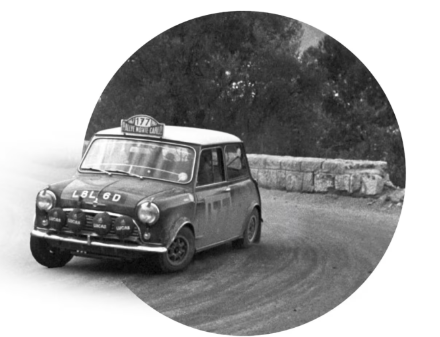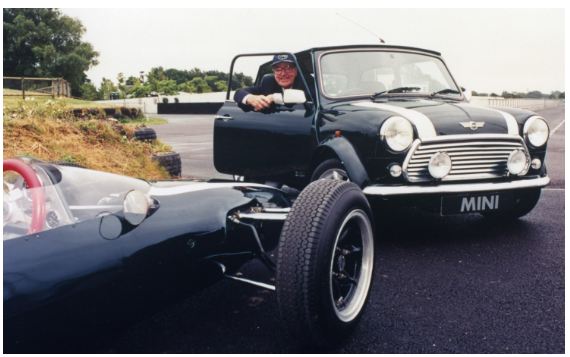The original Mini was first produced between April and August 1959, with a number of different Mini models made in the years of production that followed.
This guide takes a deep-dive into those first production years and explores the timeline of classic Mini production from start to finish. So, whether you’re a classic Mini owner or just looking to spruce up your knowledge of automotive history, you’re in the right place.
When Was the Classic Mini First Produced?
The classic Mini first entered production in 1959, marking the start of a new chapter in classic car history. The initial launch unfolded over several months, with original models like the Austin Seven and the Morris Mini Minor (better known as the Austin Mini) produced between April and August of that year.
Between 1957 and 1959, the Mini was designed by Englishman Alec Issigonis for Morris Motors (a company that would later be renamed as the British Motor Corporation or BMC) as an innovative response to the Suez oil crisis.
The Mini was first shown to the press in April 1959, creating a lot of excitement in the industry. By August, several thousand cars had already been produced and were ready to be sold to their new owners. On 26 August 1959, the Mini was officially announced to the public.
Popularity instantly soared after this first production launch, which created a strong demand for continued production efforts over the years.

Image Source: Mini
When Did the Classic Mini Stop Being Produced?
The classic Mini stopped being produced in October 2000.
The final Mini, a red Mini Cooper Sport, rolled off the production line at the Longbridge plant in Birmingham, England, marking the end of an era for the iconic car that had been in continuous production for 41 years since its launch in 1959.
The production of the “new” MINI began shortly after, in 2001, signalling a major transformation in British motoring and production. This relaunch introduced a modern version of the beloved classic, ensuring the Mini's legacy would continue for future generations.
And it still does, to this day!
Classic Mini Production Years & Intervals
Mark I: 1959–1967
The classic Mini made its production debut in 1959. This first generation became famous for its innovative compact design, featuring a transverse engine layout that maximised interior space despite the car’s small size.
In 1961, the Morris Mini Cooper was introduced, a sportier version of the original developed by John Cooper, a renowned racing car designer.
Cooper models like the Morris and the Austin Mini Cooper were equipped with a more powerful engine and upgraded brakes, quickly becoming favourites among driving enthusiasts and cementing the Mini's reputation as a car that was small in size but big in performance.
Mark II: 1967–1990
In 1967, the Mini Mk II was released, showcasing several updates that kept the car fresh and competitive. This version featured a redesigned front grille, a larger rear window, and various mechanical improvements, enhancing both its aesthetics and functionality.
A total of 429,000 Mk II Minis were produced, indicating its continued popularity.
The Mini production lineup expanded further in 1969 with the introduction of the Mini Clubman, which sported a squarer front design. This new variant was developed as a cost-effective way to broaden the Mini's appeal without a complete redesign.
Despite the launch of the larger and more modern Mini Metro in 1980, the classic Mini remained in production, maintaining its beloved status among car enthusiasts.
Mark III: 1990–2000
The third generation of the classic Mini began in 1990 with the introduction of the Rover Mini Cooper—a revival of the iconic Mini Cooper name after a 19-year hiatus. This version brought modern updates to the classic design, blending the nostalgic appeal of the original with contemporary features.
The classic Mini continued to charm drivers and production lines until 2000, when its production finally came to an end after over 40 years.
This was the conclusion of an era for one of the most iconic cars in automotive history, leaving behind a legacy that would continue to influence car design and culture for years to come.

Source: Mini Cooper // The legendary John Cooper sitting in the Mini John Cooper LE, sold in 1999, commemorated Mini’s 40th anniversary and Cooper's first F1 World Championship win.
Where Was the Classic Mini Produced?
First produced in England by the British Motor Corporation, then named Morris Motors, the classic Mini is famously a British car. But with the size and scale of the Mini’s global success, did production also develop overseas?
From their launch in 1959, Classic Minis were hugely popular to consumers outside of the UK, namely in France, Italy, Ireland, the Netherlands, Belgium, Germany, and Portugal. While production mainly remained in Birmingham’s Longbridge Plant, a number of overseas plants cropped up in order to keep up with supply and demand across the globe.
This included some overseas Mini production in areas such as:
- New Zealand
- South Africa
- Australia
- Chile
- Italy
- Spain
Over the course of the 41 years that the classic Mini was being produced, a number of countries would enable the growth and development of the Mini name, supporting production and distribution of the classic design around the world.
Closing Thoughts
Whether you're an original Mini enthusiast or simply curious about classic cars, the story of the Mini is one of timeless design, cultural impact, and lasting influence. From its humble beginnings in 1959 to its final farewell in 2000, the Mini not only became a British icon but also left an indelible mark on automotive history worldwide.
Hopefully, this guide has provided you with all the answers you were looking for.
If you’re a classic Mini owner looking for parts and spares, MGOC Spares has a range of classic Mini parts that could be perfect for your car project.
Shop our Classic Mini Parts catalogue today.
Classic Mini Production Years FAQs
How long was the classic Mini produced for?
The classic Mini was produced for 41 years, from April 1959 to October 2000. These years of production are known to be some of the most successful and enduring of the automotive industry, with the classic Mini leaving behind a distinct mark in terms of production, design, and innovation.
When did production for the “new” MINI begin?
The new MINI launched and began production in 2001, about a year after production of the classic Mini came to an end in October 2000. While taking notes from the classic Mini in terms of style, the modern Mini has a number of differences, both in the way it’s produced and the final product.